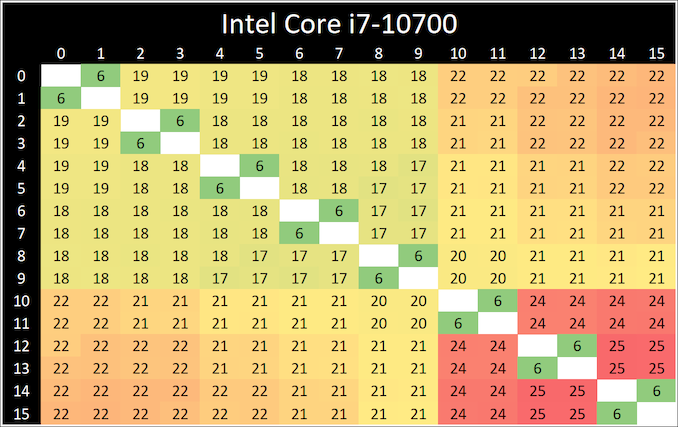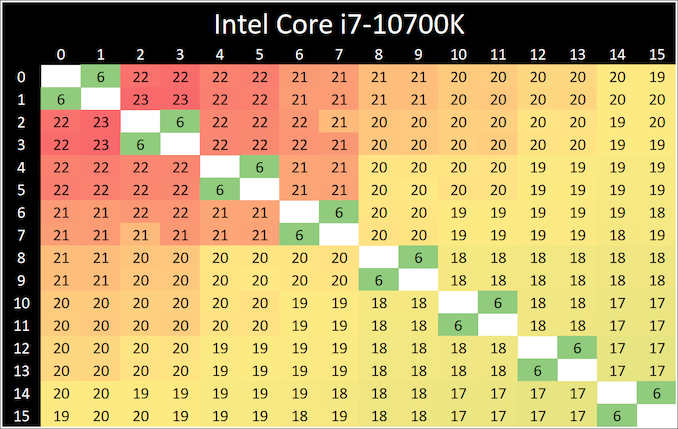Intel Core i7-10700 vs Core i7-10700K Review: Is 65W Comet Lake an Option?
by Dr. Ian Cutress on January 21, 2021 10:30 AM EST- Posted in
- CPUs
- Intel
- Core i7
- Z490
- 10th Gen Core
- Comet Lake
- i7-10700K
- i7-10700
CPU Tests: Microbenchmarks
Core-to-Core Latency
As the core count of modern CPUs is growing, we are reaching a time when the time to access each core from a different core is no longer a constant. Even before the advent of heterogeneous SoC designs, processors built on large rings or meshes can have different latencies to access the nearest core compared to the furthest core. This rings true especially in multi-socket server environments.
But modern CPUs, even desktop and consumer CPUs, can have variable access latency to get to another core. For example, in the first generation Threadripper CPUs, we had four chips on the package, each with 8 threads, and each with a different core-to-core latency depending on if it was on-die or off-die. This gets more complex with products like Lakefield, which has two different communication buses depending on which core is talking to which.
If you are a regular reader of AnandTech’s CPU reviews, you will recognize our Core-to-Core latency test. It’s a great way to show exactly how groups of cores are laid out on the silicon. This is a custom in-house test built by Andrei, and we know there are competing tests out there, but we feel ours is the most accurate to how quick an access between two cores can happen.
When we first reviewed the 10-core Comet Lake processors, we noticed that a core (or two) seemed to take slightly longer to ping/pong than the others. These two parts are both derived from the 10-core silicon but with two cores disabled, and we still see a pattern of some cores having additional latency. The ring on the 8-core parts still acts like a 10-core ring, but it all depends on which cores were disabled.
Frequency Ramping
Both AMD and Intel over the past few years have introduced features to their processors that speed up the time from when a CPU moves from idle into a high powered state. The effect of this means that users can get peak performance quicker, but the biggest knock-on effect for this is with battery life in mobile devices, especially if a system can turbo up quick and turbo down quick, ensuring that it stays in the lowest and most efficient power state for as long as possible.
Intel’s technology is called SpeedShift, although SpeedShift was not enabled until Skylake.
One of the issues though with this technology is that sometimes the adjustments in frequency can be so fast, software cannot detect them. If the frequency is changing on the order of microseconds, but your software is only probing frequency in milliseconds (or seconds), then quick changes will be missed. Not only that, as an observer probing the frequency, you could be affecting the actual turbo performance. When the CPU is changing frequency, it essentially has to pause all compute while it aligns the frequency rate of the whole core.
We wrote an extensive review analysis piece on this, called ‘Reaching for Turbo: Aligning Perception with AMD’s Frequency Metrics’, due to an issue where users were not observing the peak turbo speeds for AMD’s processors.
We got around the issue by making the frequency probing the workload causing the turbo. The software is able to detect frequency adjustments on a microsecond scale, so we can see how well a system can get to those boost frequencies. Our Frequency Ramp tool has already been in use in a number of reviews.
Both processors ramp from idle to full turbo in about six milliseconds, well within a single frame of standard gaming.













210 Comments
View All Comments
Marlin1975 - Thursday, January 21, 2021 - link
"65 watt" you keep using that word, I don't think it means what you think it means.YB1064 - Thursday, January 21, 2021 - link
From the first peak power chart, the 10700K consumes almost twice as much power as an equivalent AMD offering at that price point. The "65W" number is blatantly false advertising.heickelrrx - Friday, January 22, 2021 - link
10700k is not 65w part, 10700 is the one that labeled as 65wSamus - Friday, January 22, 2021 - link
Intel is just lying at this point as they are 'effectively' ~215w parts if you put them in a motherboard from Asus, Asrock, MSI, Gigabyte, etc. Only in an OEM system like an HP Elitedesk or Dell Workstation will they run anywhere close to their TDP rating but I'd guess they are using PL2 as well because why not, Intel said its ok.It's become painfully obvious Intel has had to resort to extreme measures here to compete. And compete is a pretty loose definition as they are using almost double the power of the competition and still slower clock for clock, dollar for dollar. No wonder Intel has shaken up the ranks, this is embarrassing.
Smell This - Friday, January 22, 2021 - link
The AMD 3rd Gen Ryzen Deep Dive Review:3700X (65w) and 3900X Raising The Bar
https://www.anandtech.com/show/14605/the-and-ryzen...
I snagged a Ryzen 3700X 8c/16t for $280 3 months ago. The price is at $325 or so these days until it is supplanted by a Ryzen 5700X. Makes the Core i7-10700 at 197w very, very sad.
Fully loaded (by Andrei & Gavin) was around 90w.
bananaforscale - Monday, January 25, 2021 - link
Doesn't matter, 10700 isn't really a 65W part either. I can deal with a 105W Ryzen pulling 150W under full load but having a "65W" part pull 215W is just BS. That's over triple and will overstress crap VRMs.III-V - Friday, January 22, 2021 - link
It's peak power... Not sustained power, which is what TDP deals with.shabby - Saturday, January 23, 2021 - link
It's 2.9ghz base clock uses 65w, that's what the tdp rating basically is.It would be nice if anandtech posted the actual wattage during each test for each cpu. Not just for many fps it got but how much wattage it used in that test.
Qasar - Saturday, January 23, 2021 - link
specially for games. keep reading how some say in games, intel is still better then amd when it comes to power usage, but dont really see much about it.scottlarm - Saturday, January 23, 2021 - link
gfh